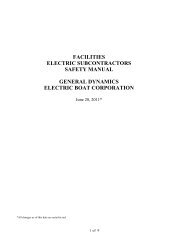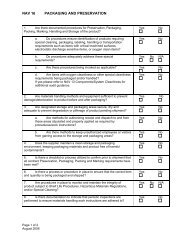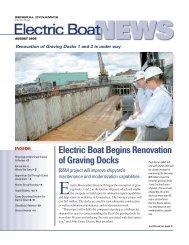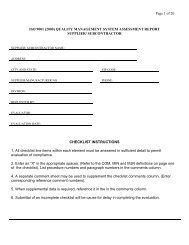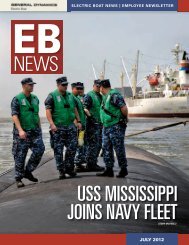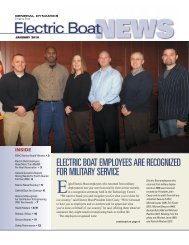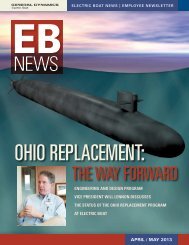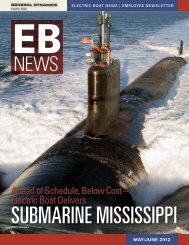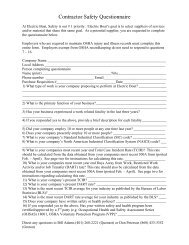ADMIRAL RECOGNIZES EB WORKERS - Electric Boat Corporation
ADMIRAL RECOGNIZES EB WORKERS - Electric Boat Corporation
ADMIRAL RECOGNIZES EB WORKERS - Electric Boat Corporation
Create successful ePaper yourself
Turn your PDF publications into a flip-book with our unique Google optimized e-Paper software.
Improving The Flow Of Material At <strong>Electric</strong> <strong>Boat</strong>:A Significant Step Toward The $2B Ship“The process is extremely, extremely complicated.“We’re trying to simplify it.”Blair Decker, director of material acquisitionProvide <strong>Electric</strong> <strong>Boat</strong> shipbuilders with the rightmaterial, in the right location, at the right time,in the right quantity and the right level of quality.That’s the objective of a comprehensive, companywideinitiative to improve the material-flow process.It’s also an important step toward the ultimate goal ofreducing the cost of a Virginia-Class submarine to $2billion, in this case, by squeezing the construction timefrom 72 months to 60 months or less.According to Blair Decker, director of material acquisition,his organization annually buys some $1 billion inmaterial, ranging from washers worth pennies to multimilliondollar main propulsion units.The task of material management – getting everything<strong>Electric</strong> <strong>Boat</strong> needs to function as a business andbuild nuclear submarines – comprises several specificsteps involving virtually every functional organization inthe company, Northrop Grumman Newport News, thesupplier base and the Navy. The degree of difficulty isincreased by schedule and requirements changes andvendor performance.“The process is extremely, extremely complicated,”said Decker. “We’re trying to simplify it.”Helping Decker with this effort are Toby Miller, managerof planning and materials at Quonset Point; NancyBeckwith, manager of supplier quality; John Azzinaro,manager of shipyard support; Ed Pellegri, manager ofplanning at Groton; and Jason Thomas, manager ofquality at Quonset Point. The project leaders, LarryVandusen and Marc Macintosh, leveraged process engineeringorganization resources to provide guidance andsupport for this initiative.The work kicked off about five months ago whenprocess improvement practitioners who are deployedthrough <strong>Electric</strong> <strong>Boat</strong> began collecting and assemblinginformation. Known as green belts and black belts, theseexperts used that data to develop an understanding ofthe complete material flow process “as is.” This is calleda current-state map.The subsequent step took place last month, whenabout 45 representatives from design, engineering, planning,contracts, procurement, transportation, quality,operations, Newport News, SUPSHIP and process engineeringconvened to conduct a four-day Material FlowValue Stream Analysis (VSA).“A Value Stream Analysis is a strategic evaluation ofthe performance of a process,” explained Macintosh, amaster black belt in process engineering. “At a highlevel, you look at segments of the process and determinewhether they’re performing to customer expectations.You also develop an understanding of the problemsassociated with the process from the people who own it.“The other piece of the VSA looks forward – what dowe want this process to look like 10 years from now andhow do we want it to perform,” said Macintosh.Decker offered another perspective. “For me, a VSAenables us to see the who, what, where, how and why ofthe process. If what we’re doing doesn’t add value anddoesn’t contribute to the success of the business – let’sstop doing it. Then you move from there. Where do Iwant to be in a few years? After that, with the guidanceof the process improvement folks, I start thinking aboutwhere I want the process to be in 10 years,” he said.The future-state vision Decker referred to was developedby the VSA participants during their session andcompared with the current-state map. The group identifiedthe differences, and drew up a list of improvementitems required to move from the current state to thefuture state.“At the end of the VSA event, we had a 10-yearvision and five-year strategies to achieve that vision,”said Macintosh. “We also had a list of 70 improvementitems that identified specific actions to take in the immediatefuture. We’ll review the execution status of theseitems weekly.“Process improvement is about change – not beingsatisfied with the way the business is performing nowand wanting to better meet our customers’ needs,” hesaid. “In this case, we’re trying to provide materials tothe trades when they want them. They are the customerand we need to give them all the tools and informationthey need to do their jobs.”The green belts and black belts who were critical tothe success of this event included David Smallridge,Rick Bliven, Cliff Dutrumble, Ryan Little, Chris Barrett,Steve Christina, Jen Doro, Bob Buffkin, Carol Pepin,Nik Iacono and Bob Gillies.6 I SEPTEMBER 2007 I ELECTRIC BOAT



